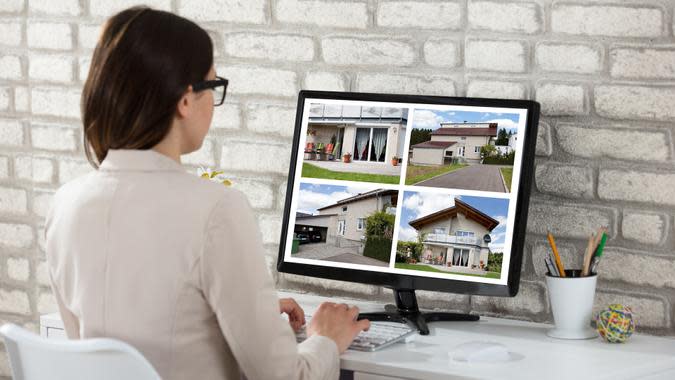Here’s Exactly How to Save for Your House Down Payment in 5 Years (or Less)

One of the biggest obstacles to buying a home can be saving enough money for a down payment-- especially if your goal is to save 20% of the price of the home. Paying 20% down can benefit a homebuyer in multiple ways, such as reducing the mortgage loan's interest rate, lowering the cost of monthly mortgage payments and eliminating the need for private mortgage insurance.
Check Out: 19 Effective Ways To Tackle Your Budget
Learn More: 50 Easy Things You Should Do To Save Money
Of course, there are a lot of factors that can determine how quickly you can set aside enough to make a down payment on a house. But there are steps you can take to help ensure you reach your goal sooner rather than later.
Get Started: Make a Debt-Free Future Your Reality
Click through to find out what you can do each month to save for a down payment in five years or less to buy a house.

Month 1: Get Familiar With the Housing Market in Your Area
Before you'll know how much you need to save for a down payment, you need to have an idea of what you want in a house and how much that sort of house will cost. Winnie Sun, the founder of Sun Group Wealth Partners, recommends making a list of must-haves for your new home. It could be a certain neighborhood, proximity to good schools or your work, a specific number of bedrooms or a yard where your pets or kids can play.
Then research prices for local home listings online that meet your criteria. You might discover that you need to adjust your expectations. Of course, the housing market could change over the years as you save for a down payment. But you don't want to work hard to save only to discover when you're ready to buy that you can't afford even the most modest home, or, the opposite, that you didn't need to scrimp quite so much to come up with a down payment.
Read More: 8 Insider Tips to Get Rich in Real Estate

Month 2: Figure Out How Much House You Can Afford
Once you get a feel for the housing market in your area and are ready to start saving, figure out how much house you can afford. To do that, calculate how much of a monthly mortgage payment you could handle on your own or with a significant other if you're buying with someone else, said Emily Gowen, owner of PDX Money Coaching.
You can use an online mortgage calculator, which will require you to enter a home price and down payment amount. These can be estimates based on the housing market research you did in month one, but you'll get an idea of what your mortgage payment will be depending on the home price and how much you put down. "Once you know what a responsible price tag for your future home would be, you can create a goal to save say 5% to 20% for a down payment, plus closing costs, moving expenses and furnishings," Gowen said.
Learn: The 50/30/20 Rule: Is It the Best Budgeting Method?

Month 3: Set a Savings Goal
When you have an idea of how much house you can buy based on the monthly mortgage you can afford, you can set a down payment savings goal. Start with the total amount you want to save then divide it by the number of months over which you plan to save to figure out how much to set aside each month.
For example, the median price of homes sold in the U.S. is $383,281, according to Redfin data from November 2021. To save 20% of the down payment, or $76,756.20, you would need to put aside $1,277.60 per month for the next five years. Of course, the actual sales price of the home you want to buy may be more or less than the U.S. median sales price, which would change the amount you would need to save.
The Economy and Your Money: All You Need To Know

Month 4: Create a Budget
Gowen saved $20,000 in two years for a 5% down payment on a home in Portland, Oregon. "When I first started saving, I began by writing down every penny I earned each month, and everything that I spent," she said. "Just through the act of keeping track, I spent less money and made better choices." To make tracking her spending easier, she decided to use a budgeting tool.
Tawnya Redding also created a budget to help her save for a down payment in four years. "Once I built a budget, I knew exactly what expenses I had and how much I was putting away," said Redding, who writes about personal finance on the blog Money Saved Is Money Earned.
Keep Reading: Tips and Tricks to Take the Fear Out of Budgeting

Month 5: Treat Down Payment Savings Like a Monthly Bill
Creating a budget and tracking your spending can help you reach your savings goal. But actually setting aside money can take discipline. That's why Gowen recommends treating your house savings goal like it's a bill. Set up an automatic monthly transfer from your checking account to a high-yield savings account. You might be able to have a portion of your paycheck deposited into a savings account. Then the money will come out before you have a chance to save it.

Month 6: Reduce Your Current Housing Costs
To create more room in your budget to save for a down payment, you might need to reduce your current housing costs. Gowen kept her rent low -- about $550 a month with utilities -- by sharing a house with friends. Redding moved back in with her parents after graduating from college in 2009 to save money. "They were kind enough to allow me to stay there until I bought my house," she said. "I paid them a reduced rent and helped around the property to compensate them."
If you can reduce your housing costs by getting a roommate, moving back home or moving to a place with cheaper rent, add that extra cash to your automatic monthly transfer to savings.
Find Out: How to Save for a House While Renting

Month 7: Keep Spending to a Minimum
Gowen was able to save more than $1,000 per month because she was committed to keeping her expenses low. For example, she bought used smartphones and kept her phone bill to $40 a month with a Straight Talk Wireless plan. But she didn't eliminate all non-essential spending from her budget.
"Even though I was trying to save half of my take-home pay each month, everyone needs a little spending money," she said. She just made sure to create a discretionary spending category in her budget so she would have money to cover outings or the occasional trip to the thrift store to buy clothes without shortchanging her savings.
Read: The Best Place to Buy a House in Every State

Month 8: Create a Plan to Pay Down Your Existing Debt
Before saving for a down payment, Redding focused on paying off her student loan debt. Without monthly debt payments, she was able to set aside more for a home. She knew she needed to save 20% for a down payment because that would make her monthly mortgage payments more affordable. Plus, it would help her avoid the additional cost of private mortgage insurance, which lenders require homebuyers to get if they make a down payment of less than 20 percent.
"Having no debt also increased my buying power, as lenders will only let you borrow up to a certain amount based on your debt to income ratio," she said. In a hot housing market like Portland, Redding knew she needed as much buying power as possible.

Month 9: Boost Your Income to Build Savings
You can only cut expenses so much. That's why Sun said it's important to focus on boosting your income to save enough for a down payment. You could ask your employer for more hours, negotiate a raise, search for a higher paying job or simply adjust your tax withholding to keep more of each paycheck rather than waiting for a refund each spring.
Redding boosted her income by getting her master's degree while working as a teacher, she said. With the higher degree, her income jumped from $35,000 to $45,000 -- which helped her increase her down payment savings.
Thinking Big? How to Get a Mortgage for $1 Million or More

Month 10: Find Side Hustles
You also can boost your income by finding ways to make extra cash. "Side-hustle your way to your down payment," Sun said. You could set up an eBay store, find gigs on Fiverr or Craigslist, freelance or do odd jobs, she said.
Redding worked multiple jobs -- from tutoring to freelance writing to coaching basketball -- to save money faster. "In addition to my full-time income, I probably made between $5,000 to $10,000 extra a year with my part-time jobs," she said.

Month 11: Research Low Down Payment Loans
If you've cut costs and boosted your income but still won't be able to save enough for a 20% down payment, look into loans that require a smaller down payment. "I had saved a good portion of a down payment for my first home and started talking to mortgage lenders," Gowen said. "I was grateful they told me not to wait until I had 20% down. Even though that means you'll pay PMI until you've paid off 20% of the principle of your house, sometimes it's worth it to just get in the market before prices go up."
The average down payment was 7.6% of the median home sales price in 2017, according to real estate data provider ATTOM Data Solutions. With an FHA loan issued by a lender approved by the Federal Housing Administration, homebuyers only need to make a 3.5% down payment.
Using the median home sales price of $383,281 that was referenced earlier, a 3.5% down payment of $13,414.83 would be much more affordable, and you might be able to reach your savings goal more quickly. You could save that amount in one year by putting aside $1,117.80 per month or in five years by saving only $223.58 each month.

Month 12: Keep Yourself Motivated to Save
If it takes several years to save enough for a down payment, you might need to come up with ways to keep yourself motivated to reach your goal. As she was saving $56,000 for a 20 % down payment, Redding said she had to give herself pep talks. "I kept telling myself that if I could just keep it up a little longer, I'd be able to move into my own place and be working toward building equity rather than spending for housing that I would never own," she said.
Make a list of the benefits of being a homeowner or print out a picture of a home you want. Post your list or picture somewhere you can see it so you'll be reminded why you're working hard to save. Hopefully, that will help keep you on track to reach your goal as you continue to implement these month-by-month steps over the years as you save.
If you've made it through a year of saving and still haven't reached your goal, repeat the process and look for ways to improve until you do.
Click through to read more about the startling facts that blindside homebuyers.
More From GOBankingRates
We make money easy. Get weekly email updates, including expert advice to help you Live Richer™.
This article originally appeared on GOBankingRates.com: Here’s Exactly How to Save for Your House Down Payment in 5 Years (or Less)
